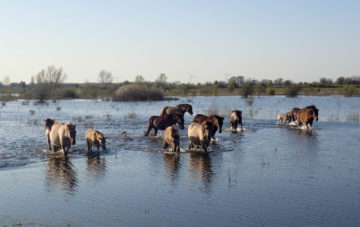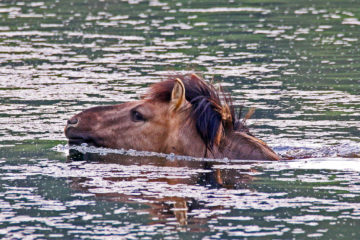Imagine a magnificent wild stallion crossing a shallow, braided river, using natural gravel beds as stepping stones – it’s hard to think of a more spectacular Dutch wildlife experience. Today this phenomenon can be witnessed regularly when hiking the restored floodplains of the River Meuse on the Belgian-Dutch border.

It is here that ARK Nature is focusing its efforts as part of the GrazeLIFE project. Kicking off at the beginning of 2019 and running through until the end of 2021, the aim of this initiative is to map the effectiveness and costs of grazing in eight different European regions (encompassing 11 European countries). This will then enable the most effective models to be better supported by EU policies and legislation going forwards.
The fact that more or less free-roaming herds of bovines and horses are allowed to shape the landscape around the River Meuse in this area is unique. And in crossing the river, the horses have no idea they are also navigating the vagaries of international law. In the first of a three-part blog series on the project, Deputy Director of ARK Nature Esther Blom tells us more.
The fall and rise of Dutch grazing
I have been working for ARK Nature for three years now. Although I have worked in international nature conservation throughout my career, it is only now that I start to grasp the complexity and richness of the concept of nature restoration – or rewilding, to use a more popular term. After three years of being immersed in the pure passion of my ARK colleagues and others for nature, I am starting to realise that the devil is so much in the details.
Determining what these details are requires a very deep knowledge of the ecosystems in which we work. Not so much the knowledge of the taxonomy of individual species, but the functioning of the natural ecosystem as a whole. This includes the myriad interactions between various species – where a complex web of relationships creates the most diverse ecosystems – and the interactions of animal and plant species with abiotic factors like water and soil. All very fascinating!

The GrazeLIFE project offers me a fantastic opportunity to dive further into one the most important aspects of rewilding: natural grazing. Having almost no real wild large herbivores left in the Netherlands since the wild ancestors of our cattle and horses became extinct, ARK started with the reintroduction of large grazers more than 30 years ago.
Konik horses, Scottish highland cattle, Tauros, Galloway cattle, red deer and European bison – all of these landscape architects have altered and enriched Dutch landscapes. And don’t forget the beaver, which we introduced too and which has also had a significant impact on the landscape. Today numerous Dutch nature reserve managers work with grazers, benefitting from the way in which the animals of these semi-wild herds interact with vegetation and with each other.
Project progress
My colleagues and I have now conducted many Graze LIFE project interviews with land managers and farmers along the River Meuse, on the Belgian-Dutch border. Through these we have increasingly come to understand the differences between various forms of grazing. And through this knowledge we are establishing and describing the crucial differences between various land management models involving domesticated and semi-wild herbivores.
Three very interesting effects of these different forms of grazing come to light when you dig deeper into the subjects of dung, bull pits (the holes that bulls dig to mark their territory) and the expansion of territorial areas. In this blog, I want to start by exploring the last of these.
The benefits of permanence
Semi-natural herds, or better “semi-natural populations” of grazers, consist of a steady group of animals of various ages and more or less equal sex distribution, with a constant presence in their territorial area. The effect of this permanency is self-confidence. Young animals learn from their elders which areas to explore, which plants to eat, and how to behave and grow up to be more exploratory animals.
The continuous presence of semi-natural grazers in an area all year round – in summer as well as winter – makes it their real home and gives them an in-depth knowledge of the terrain, including less accessible areas. Herd managers and water managers have told us in interviews that this is a big advantage of semi-natural populations, compared to herds that have no bull, unequal sex distribution, less balanced age distribution and so on. With semi-natural herds, grazing pressure is more equally divided over the whole area and forest development is therefore widely suppressed. Herds can even open up closed forests through debarking or uprooting trees. This contributes to better flood protection in some areas, because river flow is less obstructed without forests. An excellent example of how various ecosystem functions combine!
A natural spectacle

In semi-natural herds of horses, long-term presence and equal sex distribution means young stallions eventually look to avoid competition with dominant stallions by trying their luck with mares in other nearby areas. In the Grensmaas region, this involves a brave swim across the River Meuse to check out herds on the other side of the water.
Because the Meuse forms the border between the Netherlands and Belgium at this point, these itinerant stallions are entering a foreign country. From a natural perspective this is good news, because it introduces new genes into populations. From a recreational perspective, the picture is more mixed.
Patrick van den Burg, a herd manager at FREE Nature, tells us that on the Dutch side of the Meuse many hikers come to visit the area to enjoy the natural behaviour of horses, including the river crossing. It really is a magnificent sight. On the Belgium side, however, visitors are less accustomed to this display of natural behaviour and are sometimes shocked by the fights that occur between the rival stallions. These can sometimes be rough and horses do get injured. On the Dutch side of the river, people have become familiar with this spectacle and know that such injuries heal naturally most of the time. The fighting actually strengthens the herd because it ends up with the strongest lead stallion. But on the Belgian side, this behaviour causes more discomfort amongst nature managers and the public. Fortunately, Dutch and Belgian nature managers keep in touch and exchange opinions and feelings about these occurrences, which helps to promote mutual understanding. They learn a lot from each other.
Chasing status
Another issue highlighted by these events is that national and EU laws and regulations do not take into account animals naturally traversing borders. In crossing the Meuse, the stallions become more or less illegal citizens, without status. For the horses, the current solution is that they are either brought back, or allowed to stay in their new habitat if they become lead stallion.

For the Galloway cattle, things are much more complicated. The Belgian herd has IBR (Infectious Bovine Rhinotracheitis)-free status at a national level. If Dutch Galloway bulls or cows, which are healthy but do not enjoy the same status, were allowed to cross the river and mingle with their Belgian counterparts, the entire Belgian herd would lose its status. So big economic interests are at stake here.
My colleagues Renee Meissner and Hettie Meertens have been flagging this issue for years. One possible solution suggested by Dutch policy makers is to have the entire nature reserve, on both sides of the border, declared a separate zone. This option is being explored and discussed with the governments and herd managers on both sides of the border. Under the umbrella of GrazeLIFE, this could set an excellent example for other border areas. It would also be another small step towards giving semi-natural grazers the status they deserve: that of wild animals.
Esther Blom, Deputy Director of ARK Nature